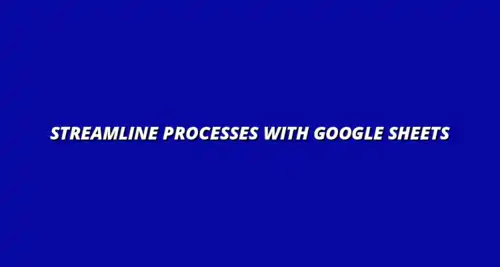
- Workflow Tips
- Dec 29
2024-12-27
In today's fast-paced business world, efficiency is key. That's where Google Sheets comes into play. It serves as a powerful tool for automating processes, making it easier for teams to track tasks, manage data, and improve overall productivity.
Many businesses, including ours at [Your Business Name], have found that embracing automation through Google Sheets not only saves time but also reduces errors. This tool transforms how we handle everyday tasks, allowing us to focus more on strategy and less on manual work.
Google Sheets has evolved into an essential platform for automating various business processes. With its ability to connect with other Google tools and third-party applications, it serves as a central hub for managing workflows. We can automate everything from data entry to report generation, which helps in streamlining operations.
Additionally, Google Sheets allows for easy collaboration among team members. Everyone can access, edit, and share information in real-time, promoting transparency and enhancing teamwork. When we collaborate seamlessly, it boosts morale and productivity!
When we think about process automation with Google Sheets, several exciting benefits come to mind. First, there's the significant time savings that comes from eliminating repetitive tasks. This means more time for creative and strategic work!
Moreover, automating processes reduces the chances of human error. With built-in functions and formulas, data entry becomes much less error-prone. I've noticed that our team is now more confident in the data we use for reporting and decision-making.
To make the most out of Google Sheets for automation, there are a few tips I've gathered over time. First, it's crucial to set up your sheets in a way that promotes efficiency. This can often mean organizing data logically and clearly.
Another important aspect is choosing the right templates. Google Sheets offers a variety of templates tailored to different business needs, which can save you a lot of hassle when starting your automation journey!
When you begin your automation setup, consider how you want your data organized. Use clear headings and consistent formatting to make data entry a breeze. This not only helps you but also anyone who collaborates with you!
Choosing the right template can dramatically impact your efficiency. Google Sheets has a wide range of templates for budgeting, project management, and more. Picking one that fits your business needs can save you time and ensure a smoother workflow.
For instance, our team at [Your Business Name] often uses project management templates to keep track of ongoing projects. It allows us to visualize progress easily and make adjustments when necessary!
Data validation is a simple yet effective feature in Google Sheets that helps prevent errors. By setting rules for what data can be entered into cells, you can maintain consistency and accuracy.
For example, if you're collecting dates, you can configure your sheet to only allow date entries. This small step can save you a lot of headaches later on!
One of the most powerful features of Google Sheets is its extensive library of formulas and functions. By leveraging these, you can automate calculations, data manipulation, and even reporting.
In our experience, using these functions has made a noticeable difference in how quickly we can generate reports and analyze data. It frees up time for more critical tasks!
There are several formulas that are especially helpful when automating processes. Here are a few common ones that I've found to be incredibly useful:
Array formulas are a game-changer for anyone looking to streamline their data management. They allow you to perform calculations on an entire range of cells at once instead of one by one.
This feature can significantly reduce the time spent on repetitive calculations and can keep your sheets cleaner and more organized. It’s a fantastic way to enhance efficiency!
If you're looking to take your Google Sheets automation to the next level, Google Apps Script is worth exploring. This scripting language allows you to create custom functions and automate complex tasks that go beyond standard formulas.
Many businesses, including ours, have benefited from using Scripts to automate repetitive tasks like sending out reports or updating records. It’s a powerful way to enhance efficiency!
Before diving into scripting, it’s essential to understand what Google Apps Script is. It’s a JavaScript-based language specifically designed to interact with Google Workspace applications, including Google Sheets.
With just a little effort, you can learn to write simple scripts to automate tasks that would normally take much longer. This can be incredibly beneficial for saving time!
There are numerous examples of scripts that can help automate tasks. Here are a few that I've found particularly useful:
By implementing these scripts, you can significantly reduce the time spent on manual tasks and ensure consistency in your processes!
When we think about workflow efficiency, it's crucial to evaluate how automation really affects our daily processes. By automating tasks within Google Sheets, we can save time and reduce manual errors. This not only streamlines operations but also allows team members to focus on more important activities.
One way to measure the success of our automation efforts is by tracking key performance indicators (KPIs). These KPIs often include time saved, error reduction, and overall productivity increases. By regularly reviewing these indicators, we can see the tangible benefits of our automated processes!
Identifying the right KPIs is vital for understanding the impact of automation on our workflow. Here are some essential KPIs to consider:
By paying attention to these KPIs, we can adjust our automation strategies as needed. For example, if time savings are minimal, it might be time to refine your existing automation methods!
Feedback is a powerful tool in any automation strategy. It’s essential to gather input from team members about their experiences with automated processes. This feedback can help identify areas for improvement or further automation.
Implementing a routine review process can keep our strategies current. Here are some steps you might consider:
Continuous improvement ensures that our automation strategies remain effective and relevant. By adapting based on real-world use and feedback, we can make our workflows even more efficient!
The world of automation is always changing, and staying ahead of trends can give us a competitive edge. As technology advances, Google Sheets is likely to evolve too, offering new features that can enhance our automation efforts. I can’t wait to see what’s next!
Automation tools, including Google Sheets, are becoming more sophisticated. Here are some trends to watch for:
Staying informed about these trends will help us leverage new features effectively and maintain our productivity!
As new updates roll out, it’s vital to prepare for their implications on our workflows. Keeping an eye on Google’s announcements can help us anticipate shifts in our processes. Here’s how to prepare:
By preparing for upcoming changes, we can ensure we’re always making the most of Google Sheets and our automation strategies!
In summary, embracing automation using Google Sheets can significantly enhance workflow efficiency. By measuring success through KPIs and continuously improving based on feedback, we can streamline our processes. Plus, keeping an eye on future trends will position us well for success!
Here’s a quick recap of the strategies we've discussed:
These strategies will help you maximize the potential of Google Sheets in your business!
Now that you have these insights, it’s time to take action! Begin by identifying a few repetitive tasks in your workflow that could benefit from automation. Start small, and as you see success, gradually expand your efforts. Remember, automation is a journey, not a sprint!
Embrace the change, and watch how Google Sheets can transform your business processes!
